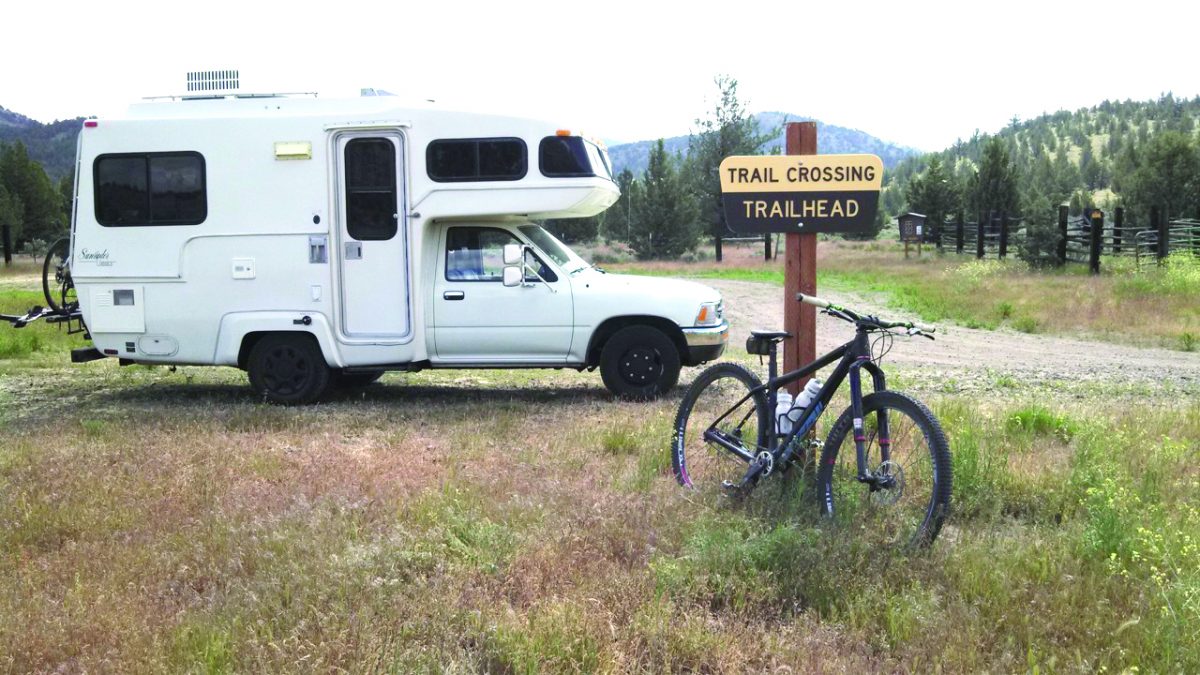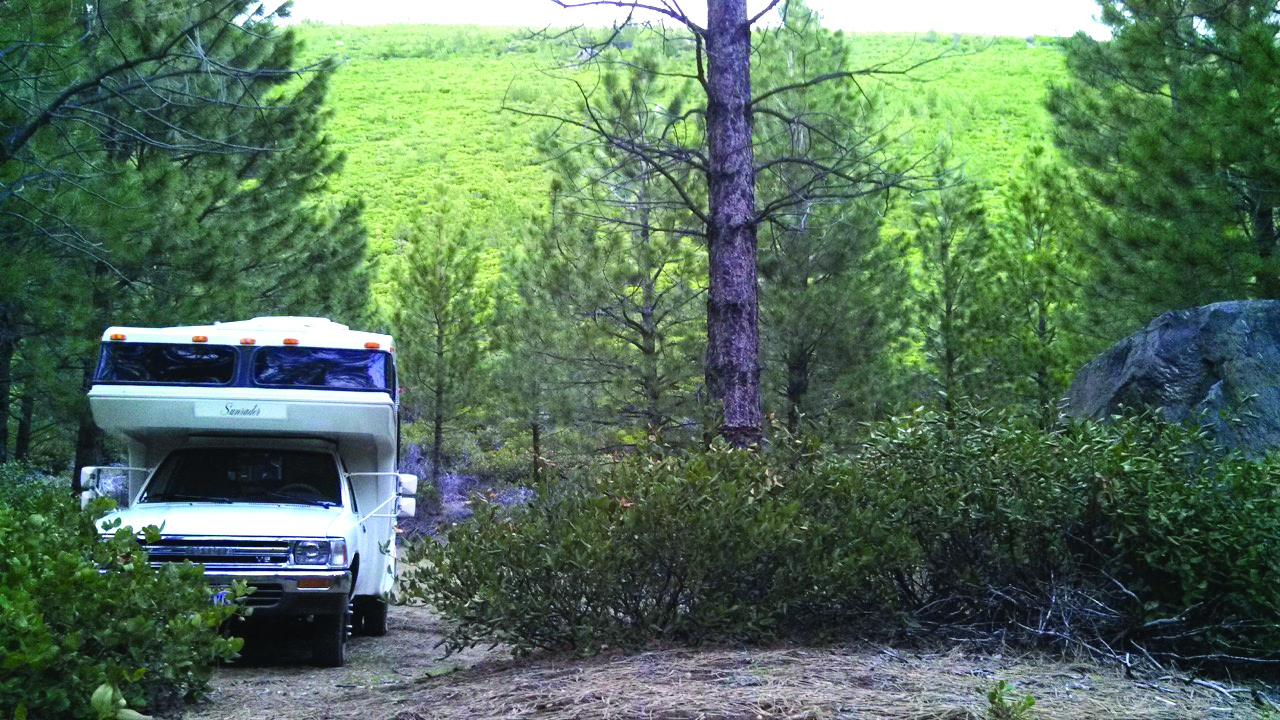VANLIFE: Sunragin’
Originally posted on June 23, 2017 at 1:45 amWords and photos by Kurt Gensheimer
At 11,542 feet above sea level, Hoosier Pass south of Breckenridge, Colorado, is not the ideal spot in which to be driving an unfamiliar RV, especially in the middle of a snowstorm. But alas, that’s where I found myself only two hours after purchasing a 1990 Toyota Sunrader sight unseen off Craigslist in fall of 2014 from an anal-retentive retired Air Force pilot named Bill in Colorado Springs. I had to make it 1,100 miles back home to Verdi, Nevada, and although I wired a complete stranger $12,000 after only seeing a dozen photos of the rig, it seemed to be too good of a deal to pass up.
Hopefully, it wasn’t too good to be true.
As soon as we rolled up to Bill’s house after he picked me up at the airport, I laid eyes on the Sunrader and knew it was a major score. Not a scratch or a dent on it, only 68,000 original miles, every single accessory and appliance in working condition, and an interior that looked fresh from the factory, it took every shred of self-control to play it cool and contain my excitement. As a bonus, Bill went through the entire vehicle to make sure it was ready for the road trip home.

Although at times it was white-knuckle going over Hoosier Pass and getting over Vail Pass in near-whiteout conditions, the Sunrader made it out of the Rockies before 2 feet of pre-Thanksgiving snow temporarily shut down Interstate 70. It was an amazing sensation of freedom having an entire miniature house on wheels. Suddenly, I was no longer in a hurry to get anywhere. If I got tired or if there was traffic, I could simply pull over and take a nap. Or I could go drive up some remote mountain road and camp in solitude, which I ended up doing in Lamoille Canyon in the heart of the Ruby Mountains south of Elko, Nevada.
This 18-foot fiberglass-shelled Toyota Sunrader on a one-ton truck platform with a boat-anchor 3.0-liter V-6 (aka 3.slow) is an extremely rare bird, even scarcer than the highly coveted Toyota Sunrader four-wheel drive made between 1985 and 1988. With barely a dozen V-6-powered, 18-foot Sunraders in existence, it’s about the most perfect livable, affordable and reliable adventure rig that’s easy to drive and small enough to park anywhere. And the “pièce de résistance”: a full-size rear window to gaze out while enjoying a sudsy post-ride beverage.

Equipped with a furnace, air conditioner, oven, stove, giant three-way refrigerator, two sleeping areas, and wet bathroom with shower and toilet, the Sunrader is way better than van life—this is full-on RV life in van-sized convenience. There’s nothing better than coming back from a wet, cold ride and being able to take a hot shower inside. You can poop in the woods if you want, but having your own private toilet at the ready is pretty damn nice, especially in the parking lot of a bike race when all the porta-johns are full. And guys, a word of advice, if you have a significant other and are in the market for a van or RV, get one with a bathroom. You’ll thank me later. I almost passed on an RV with a bathroom. I’m glad I didn’t, and so is my lady. It’s clutch.
Even though this particular Sunrader is not a four-wheel drive, I’ve taken it on plenty of rugged dirt roads that virtually every other RV wouldn’t make. For those that know South Usal Beach on the Lost Coast of California, the steep, narrow and washed-out dirt road from Highway 1 can be completely white-knuckle even in a pickup truck, especially when it’s wet. Thanks to its BF Goodrich All-Terrains and dually rear axle with a ton of weight on it, my two-wheel drive Sunrader made it to South Usal without issue, providing an oceanfront domicile for the night without a single neighbor besides a herd of Roosevelt elk. The Sunrader is surprisingly capable off-road in the snow, and it will go as deep into the bush as any two-wheel drive van or pickup with a cab-over camper.

Sunrager, Pantyraider, Moonraker—they’re all nicknames my friends have given this remarkable little piece of engineering. My lady, Swan John, calls it Bitty Bertha and gives it words of encouragement while driving to help it climb mountain passes more quickly, a practice most old Toyota truck owners are familiar with. But whatever you do, don’t call it a Dolphin, an entirely different Toyota RV, which was built with leaky wooden stick-frame construction versus the watertight clamshell molded-fiberglass construction of the Sunrader. Although the roof can’t leak, the windows sure can, and after detecting some moldy wood trim last fall, I had to tear out part of the interior and reseal the rear window. That’s the only repair I’ve had on the Sunrader in 20,000 miles of ownership.
Since purchasing the Sunrader two years ago, we have already had dozens of incredible adventures, and none of them involved breaking down in the middle of nowhere. Since I own and work on four vehicles built in the 1980s (three of them Toyotas), I’m not a fan of unreliable machines. I don’t see much character in a vehicle that continually breaks down when you need it most. I’d much rather spend my vacation time on the bike than underneath the hood fixing the myriad problems that seem to plague many other adventure rigs. Since the Sunrader is a Toyota truck, Rock of Gibraltar reliability is one of its numerous benefits.

And despite the 3.slow V-6 having notorious head gasket issues, the first mod I did after purchasing the Sunrader was putting Doug Thorley headers on it to get the exhaust heat out from behind the rear cylinders, the cause of its head gasket issues. Although it was a complete bitch clearing the exhaust pipes around the two-wheel drive suspension, I am certain that there’s now only one 18-foot, V-6-powered Sunrader in the world with Thorley headers. I only wish the Sunrader was as fast as it sounds when the exhaust rumbles like a V-8 at a stoplight.
We don’t live full-time in the Sunrader, but we did spend two months this past summer living out of it. And at the end of that span, Swan John and I both agreed that we could have kept living out of it. In the summer we spend most of our days outside anyhow. If we’re in the Sunrader, we’re eating, sleeping, working on the computer or driving. Otherwise, we’re in the great outdoors. Even in winter the Sunrader makes an ideal ski bum vehicle, as we’ve spent numerous weekends at Squaw Valley ski resort in Northern California, camped in the parking lot. For two people 6 feet tall or less, the 18-foot Sunrader is perfectly sized. You could maybe pull off a small dog or child, but any more than three people is too much.

With the exception of one night in Lincoln City, Oregon, we’ve never had our door knocked on in the middle of the night. Since we have an RV, I refuse to pay to camp. The only time I pull into an RV park is in the dead of winter when it’s nice to have shore power to run a more energy-efficient electric heater at night. When searching for a boondocking spot, we always hunt for public land—BLM and National Forests are always fair game; just pull up a dirt Forest Service road and find a flat spot. We’ve never had a problem or been hassled. If I can’t escape the mass of humanity and urban sprawl, I’ll hunt for an industrial park area with other RVs around.
I have many friends with brand-new vans, and admittedly, they’re pretty damn nice. But when you factor in how much they spent on their van versus how much I spent on the Sunrader, then factor in how much more livable the Sunrader is, I’ve never felt a shred of new-van envy.

The Sunrader
•1990 Toyota Sunrader Classic 180-RD (Rear Dinette)
•3.0-liter V-6 engine and four-speed automatic transmission
•14-inch BF Goodrich All-Terrain tires
•Doug Thorley headers
•Custom cold-air intake
•Lexus LS400 floor shifter conversion
•SR5 instrument cluster conversion
•Recaro seats from a 1985 Toyota Supra
•Rearview camera upgrade
•Dual 6-volt golf cart cabin batteries (longer burn life)
•21-gallon freshwater tank, 18-gallon grey water tank, 9-gallon blackwater tank

Future plans
Future plans include solar panels and a four-wheel drive conversion using a 1985 Toyota truck solid front axle and a five-speed manual transmission with 4.7:1 low-range transfer case. A supercharged 3.4-liter V-6 conversion from a late 1990s Tacoma might also be in the cards. But there’s no real hurry; this Sunrader is plenty capable and powerful enough just the way it is.
In search of one?
Constructed by Gardner-Pacific Corp. in Vallejo, California, between approximately 1979 and 1991, the Sunrader has had several different models over the years from 14 feet to 21 feet in length, all of them using upside-down clamshell fiberglass construction. The 18-foot model is the most desirable, built on either Toyota or Nissan one-ton truck platforms. Most 18-foot Toyota and Nissan Sunraders came with carbureted or fuel-injected four-cylinder engines, with a handful of V-6 engines out there. The 21-foot Sunraders with a V-6 are more common.
There are fewer than 20 Toyota Sunrader four-wheel drive 18-foot models left in existence, which are very hard to find and quite expensive. If you’re a skilled fabricator, doing a four-wheel drive conversion on a two-wheel drive Toyota Sunrader is not too difficult or expensive and is well documented on the internet, as many Toyota rock crawlers have been converted to four-wheel drive from a two-wheel drive pickup.
When searching for a Sunrader, the main item to be aware of is 1979-1985 Sunraders originally came with a five-lug, non-full-floating rear axle that could suddenly fail while driving. There was a factory recall for this issue, so just make sure that any Sunrader you’re looking at has had the six-lug, full-floating rear axle upgrade. The other somewhat common issue with old Sunraders is that the front cab-over wraparound plexiglass windows are prone to leaking, causing the fi ber- glass roof to sag over time.
The 3.slow V-6 isn’t known for its power or efficiency, but its 150 horsepower and 180 pound-feet of torque are far better than the anemic but bulletproof 22RE four-cylinder found in most Sunraders. Fuel economy with the V-6 isn’t great but respectable, ranging between 12 and 16 miles per gallon depending on conditions. Four-cylinders are slightly higher at 16-19 miles per gallon. But if you get a four-cylinder, get a manual transmission. The four-cylinder with an automatic is frustratingly slow.
